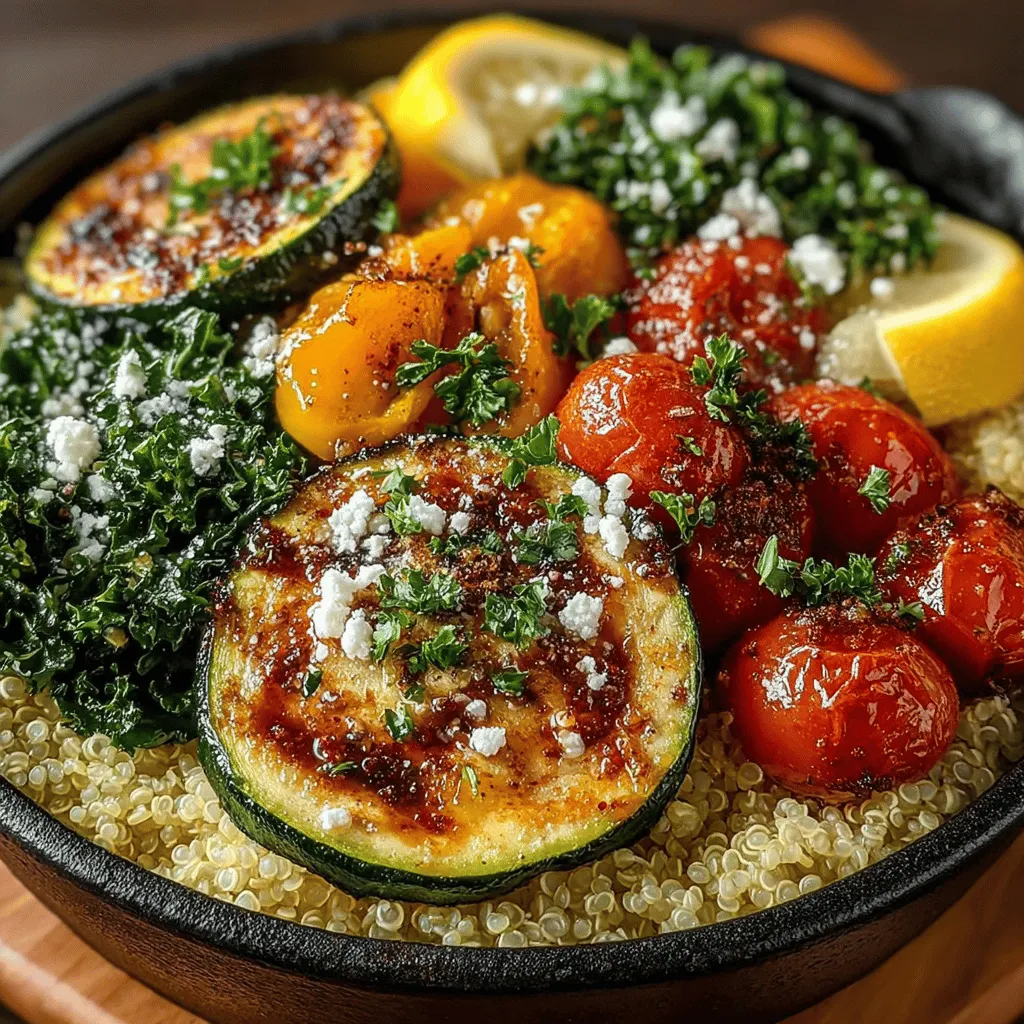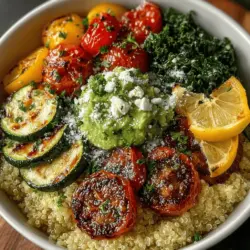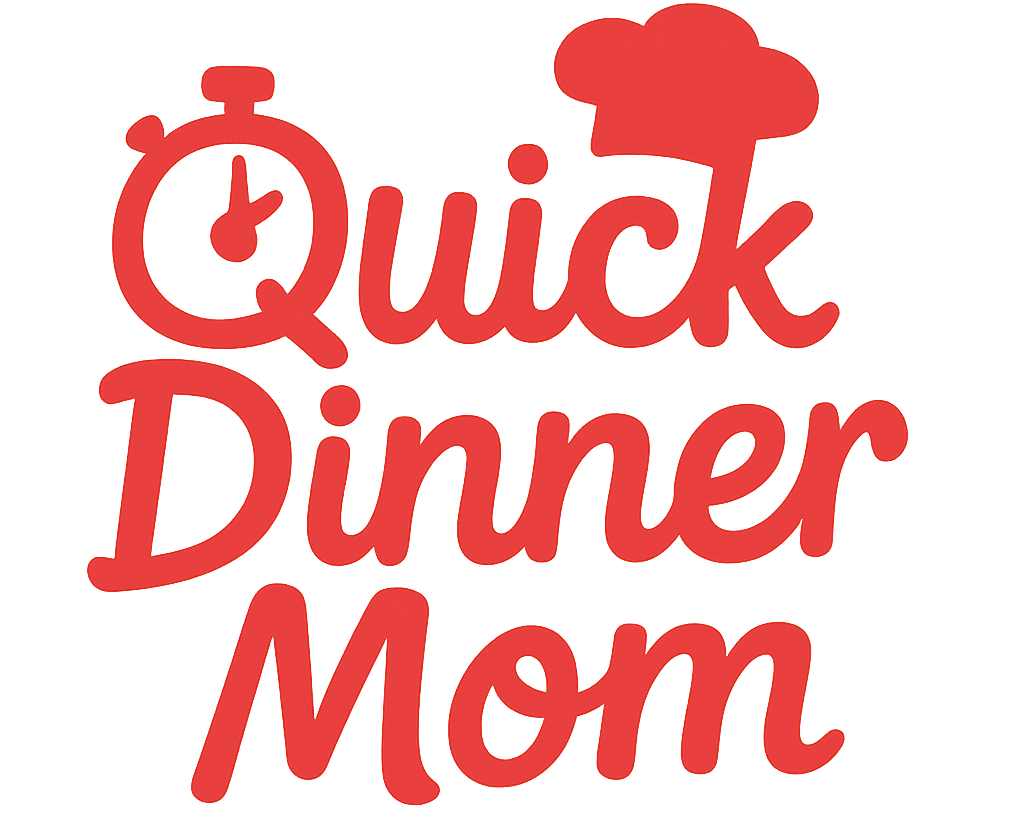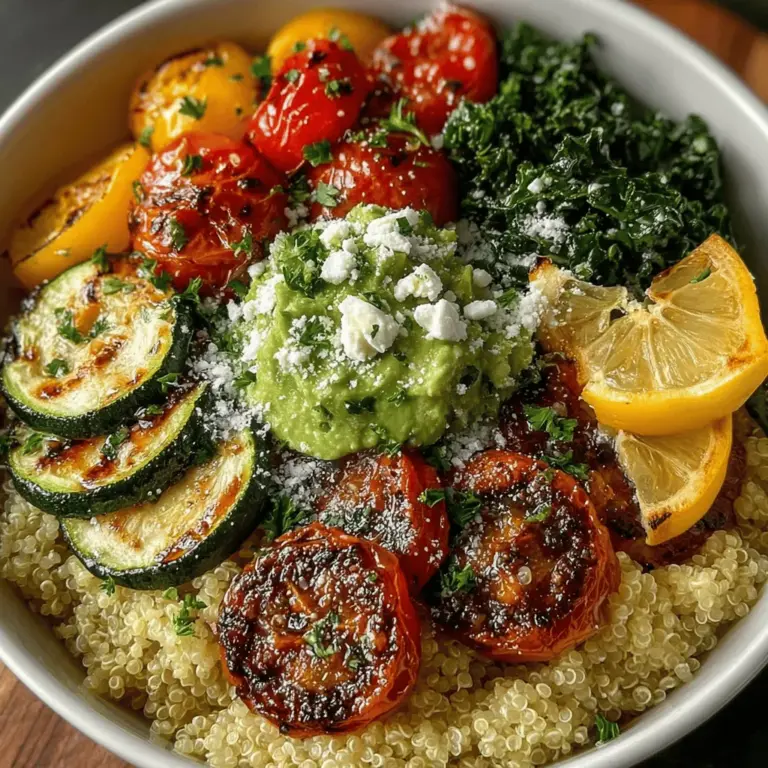Introduction
In today’s fast-paced world, finding a nutritious and satisfying meal can be a challenge. Enter the Colorful Quinoa and Roasted Veggie Power Bowls—a vibrant, wholesome dish that not only nourishes the body but also delights the senses. This recipe is packed with protein-rich quinoa, a medley of roasted vegetables, and topped with creamy avocado and feta cheese, making it a perfect choice for a quick lunch or a hearty dinner. The combination of textures and flavors in this dish creates an appealing presentation that is as pleasing to the eye as it is to the palate. This article will guide you through the step-by-step process of creating this nutrient-dense meal while also exploring the health benefits of its ingredients and providing tips for customization.
The Nutritional Power of Quinoa
Understanding Quinoa’s Nutritional Profile
Quinoa, often referred to as a superfood, is a seed that has gained immense popularity among health-conscious individuals. One of its most notable features is its high protein content. Unlike many plant-based foods, quinoa is a complete source of protein, meaning it contains all nine essential amino acids necessary for human health. This makes it an excellent dietary choice for vegetarians and vegans looking to meet their protein needs.
Moreover, quinoa is rich in dietary fiber, which is crucial for maintaining digestive health. Fiber helps regulate bowel movements, reduces the risk of colon cancer, and can aid in weight management by promoting a feeling of fullness. Additionally, quinoa is packed with essential minerals such as magnesium, iron, and potassium, which play vital roles in various bodily functions, including muscle contraction, oxygen transport, and blood pressure regulation.
As a gluten-free grain, quinoa serves as a suitable alternative for those with gluten intolerance or celiac disease. Its versatility allows it to be incorporated into various dishes, from salads to soups, making it a staple in many kitchens.
Why Choose Roasted Vegetables?
Health Benefits of Roasting Veggies
Roasting vegetables not only enhances their flavor but also elevates their nutritional profile. When vegetables are roasted, the natural sugars caramelize, resulting in a sweet, rich taste that is hard to resist. This cooking method allows the vegetables to retain more nutrients compared to boiling, which can cause important vitamins and minerals to leach into the water.
Roasting also offers the opportunity to experiment with a wide variety of vegetables, adding both color and nutrition to your meal. A diverse range of vegetables not only makes your dish visually appealing but also provides a broader spectrum of vitamins and antioxidants, supporting overall health. Whether you choose vibrant bell peppers, earthy zucchini, or juicy cherry tomatoes, each brings its unique flavor and benefits to the table.
Gathering Your Ingredients
Essential Ingredients for the Power Bowl
To create your Colorful Quinoa and Roasted Veggie Power Bowls, you will need a selection of fresh, wholesome ingredients. Here’s a breakdown of what you’ll need:
– Quinoa: This will serve as the base of your dish. Its nutty flavor and fluffy texture complement the roasted vegetables perfectly.
– Fresh Vegetables: A combination of zucchini, bell peppers, red onions, and cherry tomatoes adds color, texture, and a variety of nutrients to your bowl.
– Leafy Greens: Incorporating kale not only boosts the nutritional value but also adds a hearty element to the dish.
– Flavor Enhancers: Olive oil, garlic powder, and smoked paprika are essential for bringing out the best flavors in your vegetables.
– Toppings: Creamy avocado and tangy feta cheese add richness and creaminess, while fresh herbs can provide a burst of freshness.
Preparing the Quinoa
Step-by-Step Guide to Cooking Perfect Quinoa
Cooking quinoa is a straightforward process, but there are a few crucial steps to ensure you achieve the perfect texture and flavor.
1. Rinse the Quinoa: Before cooking, it’s essential to rinse quinoa thoroughly under cold running water. This step removes saponins, a natural coating that can impart a bitter taste if not washed away. Use a fine-mesh strainer for best results.
2. Cook the Quinoa: For added flavor, consider cooking your quinoa in vegetable broth instead of water. The general ratio is 1 part quinoa to 2 parts broth. Bring the broth to a boil, then add the rinsed quinoa. Reduce the heat to low, cover, and let it simmer for about 15 minutes, or until the quinoa has absorbed the liquid and has a fluffy texture. Once cooked, remove it from the heat and let it sit covered for an additional 5 minutes before fluffing it with a fork.
Roasting the Veggies
Now that your quinoa is prepared, it’s time to turn your attention to the vegetables. Roasting is a simple yet effective cooking method that can elevate your Power Bowls to new heights.
1. Preheat the Oven: Begin by preheating your oven to 425°F (220°C). A hot oven is crucial for achieving that perfect caramelization.
2. Prepare the Vegetables: Chop your chosen vegetables into bite-sized pieces. Aim for uniform sizes to ensure even cooking. For a colorful array, you might include diced zucchini, sliced bell peppers, quartered cherry tomatoes, and wedges of red onion.
3. Season and Toss: In a large bowl, combine the chopped vegetables with olive oil, garlic powder, smoked paprika, salt, and pepper. Toss everything together until the vegetables are well-coated with oil and seasoning.
4. Roast: Spread the seasoned vegetables in a single layer on a baking sheet lined with parchment paper. This will help with cleanup and prevent sticking. Roast in the preheated oven for 20-25 minutes, turning halfway through, until the vegetables are tender and slightly charred.
By following these steps, you’ll have perfectly cooked quinoa and beautifully roasted vegetables ready to assemble into your Colorful Quinoa and Roasted Veggie Power Bowls. In the next part of this article, we will delve deeper into the assembly process and explore how to customize your bowls for an even more personalized meal experience.

A Detailed Look at the Roasting Process
Roasting vegetables is one of the best ways to bring out their natural sweetness and flavor. The process transforms simple ingredients into a delicious and nutritious component of your colorful quinoa and roasted veggie power bowls. Here’s how to achieve perfectly roasted vegetables.
Preparing the Vegetables: Dicing and Seasoning
To start, select a variety of colorful vegetables for your power bowl. Ideal choices include bell peppers, zucchini, carrots, and red onions. Begin by washing and drying your vegetables thoroughly.
1. Dicing: Cut your vegetables into uniform pieces to ensure even cooking. Aim for a size of approximately 1-inch cubes. This not only enhances the visual appeal but allows for consistent roasting.
2. Seasoning: In a large bowl, toss the diced vegetables with olive oil, salt, pepper, and your choice of herbs (like thyme or rosemary). This seasoning adds flavor and helps create a beautiful caramelization during roasting. A general rule of thumb is to use about 1-2 tablespoons of oil per 4 cups of vegetables.
The Roasting Technique: Achieving Perfect Tenderness and Caramelization
Roasting is an art that balances time and temperature. To achieve that coveted tenderness and caramelization, follow these steps:
1. Preheat Your Oven: Set your oven to 425°F (220°C). This high temperature is key to getting vegetables crispy on the outside while remaining tender on the inside.
2. Spread Evenly: Place your seasoned vegetables in a single layer on a baking sheet. Avoid overcrowding the pan, as this can cause steaming instead of roasting.
3. Roasting Time: Roast the vegetables for about 20-25 minutes, flipping them halfway through to ensure even cooking. Watch for a golden brown color and a tender texture; these are signs that your veggies are done.
Ideal Roasting Temperature and Time: Ensuring Optimal Texture
The ideal temperature for roasting vegetables is generally between 400°F and 450°F. At 425°F, you strike a balance that promotes browning without burning. Check your vegetables after 20 minutes; they should be tender when pierced with a fork and caramelized on the edges. If they need more time, continue roasting for an additional 5-10 minutes, keeping a close eye on them.
Sautéing the Kale
The Art of Sautéing Greens
Sautéing kale not only enhances its flavor but also retains its nutrients. Unlike boiling, which can leach nutrients into the water, sautéing allows the greens to stay vibrant and packed with goodness.
1. Heat the Pan: Use a large skillet and heat over medium-high heat. Add a tablespoon of olive oil.
2. Add the Kale: Once the oil is hot, add the chopped kale. Sauté for about 3-5 minutes, stirring frequently until the leaves are wilted but still bright green.
Why Sautéing Kale is Beneficial: Retaining Nutrients While Enhancing Flavor
Sautéing kale is beneficial for several reasons. It not only softens the tough leaves but also enhances their earthy flavor. The quick cooking method helps preserve water-soluble vitamins, ensuring you get the most nutritional benefits from the kale.
Seasoning Tips for Kale: Balancing Bitterness with Salt and Oil
Kale can have a natural bitterness, which can be balanced with proper seasoning. Aim to:
– Add Salt: A pinch of salt while sautéing helps to bring out the freshness of the greens.
– Incorporate Other Flavors: Consider adding minced garlic or a splash of lemon juice to enhance the flavor profile further. These additions elevate the dish and make the kale a delightful component of your power bowl.
Assembling Your Power Bowl
Creating a Beautiful Presentation
The assembly of your colorful quinoa and roasted veggie power bowl is where creativity shines. Here’s how to layer your ingredients to create a visually stunning dish.
1. Start with Quinoa: Use cooked quinoa as the base. Its fluffy texture and nutty flavor complement the roasted vegetables beautifully.
2. Layering the Ingredients: Add your roasted veggies on top of the quinoa. Consider placing them in sections or creating a colorful mosaic with the different vegetables.
Tips for Aesthetic Appeal: Choosing Colorful Ingredients
The visual appeal of your power bowl can be heightened by choosing a rainbow of ingredients. Think vibrant red bell peppers, bright yellow zucchini, deep green kale, and orange carrots. The more colors you include, the more inviting your dish will look.
Garnishing Options: Fresh Herbs and Lemon Wedges
To finish off your power bowl, add a sprinkle of fresh herbs such as parsley or cilantro for a pop of color and flavor. A squeeze of fresh lemon juice not only brightens the dish but also enhances the taste, making it even more refreshing.
Serving Suggestions
Enjoying Your Colorful Quinoa and Roasted Veggie Power Bowls
These power bowls are incredibly versatile and can be enjoyed in various ways.
Pairing with Beverages: Ideal Drinks to Complement the Meal
For a refreshing beverage pairing, consider serving your power bowl with:
– Herbal Iced Tea: A chilled hibiscus or mint tea can add a refreshing touch.
– Sparkling Water: A splash of lemon or lime in sparkling water complements the dish beautifully.
– Light White Wine: For an adult option, a light Sauvignon Blanc pairs well with the freshness of the veggies.
Meal Prep Versatility: Making Ahead for Busy Days
One of the great advantages of the colorful quinoa and roasted veggie power bowls is their meal prep potential. The components can be made in bulk:
– Storage: Store cooked quinoa and roasted vegetables separately in airtight containers in the refrigerator for up to 5 days.
– Reheating: When ready to serve, simply reheat the quinoa and veggies in a microwave or skillet. Add fresh kale and garnishes just before serving to keep everything fresh and vibrant.
Customizing Your Recipe
Explore Variations for Every Palate
This power bowl is not just a one-size-fits-all recipe. You can easily customize it to suit your taste preferences.
Protein Additions: Chickpeas, Grilled Chicken, or Tofu
Enhance the protein content of your power bowl by adding:
– Chickpeas: Roasted chickpeas add crunch and protein.
– Grilled Chicken: For meat lovers, grilled chicken slices work beautifully.
– Tofu: For a vegetarian option, sautéed or grilled tofu provides a satisfying protein source.
Alternative Veggies: Seasonal Options to Keep It Fresh
Feel free to switch up the vegetables based on what’s in season or what you have on hand. Other delicious options include:
– Sweet Potatoes: Roasted sweet potatoes add sweetness and fiber.
– Brussels Sprouts: Halved and roasted Brussels sprouts offer a delightful crunch.
– Cauliflower: Roasted cauliflower adds a unique flavor and texture.
Vegan and Dairy-Free Adaptations: Making the Recipe Accessible to All
This recipe is already vegan-friendly, but you can make it even more inclusive by ensuring all ingredients are dairy-free. Avoid cheese garnishes, and consider using cashew cream or a dairy-free dressing for added creaminess without compromising on dietary restrictions.
Conclusion
The Colorful Quinoa and Roasted Veggie Power Bowls are not only a feast for the eyes but also a powerhouse of nutrition. With straightforward preparation steps and endless customization possibilities, this recipe is perfect for anyone looking to embrace a healthier lifestyle without sacrificing flavor. Whether you’re enjoying it for lunch, dinner, or prepping for the week ahead, these bowls are sure to become a staple in your kitchen. Embrace the colors, enjoy the flavors, and nourish your body with this delightful dish.


